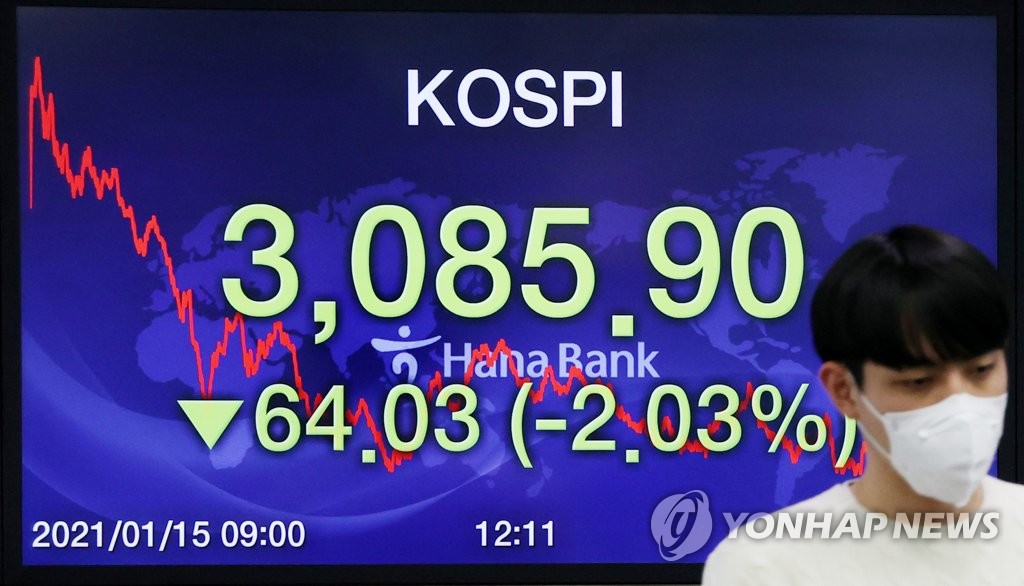
(Seoul = Yonhap News) Reporter Kim Jong-hyun = The momentum of the Donghak ant, which ran without hesitation like a bull in a bullring, was braked.
Stock prices declined as fatigue and bubble loans from short-term surges in Korea and the rise in US Treasury yields in foreign countries became bad news.
Donghak ant, who turned into a lion last year from a predator of a predator, thomson gazelle, pushed out the difficult hyenas of foreigners and institutional investors, and became the ruler of the grassland, eventually raising the KOSPI index above the 3,000 line.
On the 11th, Donghak ants pushed the index up to the 3,200 mark during the intraday by taking advantage of the enormous liquidity that is the source of the power. However, after being pushed by a bomb for sale by institutions and foreigners, it was forced to give 3,100 lines and hit the 3,000 lines now.
◇ Commissioner Men Joo-yeol warns of’debt-fighting’
Bank of Korea Governor Lee Ju-yeol, who froze the benchmark interest rate at the Financial Monetary Commission on the 15th, poured out an unstoppable warning against the stock market through a press conference.
Governor Lee said, “The recent share price rise rate is much faster than in the past,” and warned that “Investment expansion based on excessive leverage may cause losses that are difficult for investors to bear if there is a price adjustment.” In a word, he fired a direct shot at individual investors to be careful, as he may get squeezed in debt.
Even if not, the KOSPI index, which had been adjusted by 30-40 points, ended at 3,085.90, down 2.03% (64.03P), as the selling rate of institutions and foreigners increased after Governor Lee’s remarks. It may be OBI Rak, but it is difficult to rule out the possibility that it had a psychological effect on institutions and foreigners.
Although the position of central bank governor is a position that should be spared, it can be said that it is a speech of intention and an oral intervention in the market for Lee, who is silent and serious in nature.
In order to boost investment and consumption, a lot of money has been released, such as lowering the standard interest rate to the 0% level, but as liquidity has been circumvented by the stock market and housing market, the weakening of monetary policy has only increased the bubble in the asset market. That doesn’t mean it can raise interest rates. This is because the real economy is hitting the bottom. For the Bank of Korea, it is a very nasty situation of dilemma.
Not only the BOK governor, but also Hong Nam-ki, the deputy prime minister of the economy, appeared on a broadcast recently and worried about the side effects of the gap between the real economy and the stock price, saying, “If the coexistence between the real and the financial market is weakened, there may be some negative impact in the future.”
Kim Hak-gyun, head of the Research Center at Shinyoung Securities, said in connection with President Lee’s remarks, “The central bank will naturally bear the problem that the gap between the real and asset markets can cause problems in that financial market stability is the Bank of Korea’s responsibility.
◇ Will you protect Donghak Ant 3,000P… The key is interest rates
In the KOSPI market on the 15th, an individual investor supported the market with net purchases worth over KRW 2.1 trillion, but failed to overcome the selling pressures of institutions (1.4 trillion won) and foreigners (760 billion won). In the 10 business days since opening this year, individual investors have poured out over 11 trillion won, but they have been competing with institutions and foreigners to retreat between the 3,100 and 3,200 lines without driving the bull market.
Donghak Ant’s ankles are the burden of prices that have soared rapidly since December of last year, the rise in interest rates on US 10-year long-term government bonds, concerns that good news will no longer come out with the announcement of additional economic stimulus measures in the US, and a sense of caution ahead of the earnings season. Is holding.
However, experts commented that it would not be easy for the stock price to fall below the 3,000 line even if the uptrend was not reversed, and even if adjusted. In a state where the inflow of funds into the housing market is blocked due to the suppression of loans, the only way out is the stock market, supporting liquidity.
Lee Kyung-soo, head of Meritz Securities Research Center, said, “I don’t think there is any qualitative meaning other than that the index is 3,000,” he said. “The index rises by 10%, but there is a price burden. .
Jeong Yong-taek, head of the IBK Investment & Securities Research Center, said, “The key to the future is interest rates and corporate performance. If the market interest rate continues to rise, the basis of the liquidity market may be shaken. However, he expected the sideways market to continue from the level of keeping the 3,000 line to the earnings season.
Shin Young Securities, head of Research Center Kim said, “It is difficult to say that it is an adjustment that will change the trend just because it has dropped by 60 points from 600 points this year.” “In the future, the stock market will have no choice but to focus on the US 10-year Treasury yield, and if interest rates continue to rise sharply, it could be a trigger for a stock market correction in both the short and medium term,” he said.

Unauthorized reproduction-redistribution prohibited>
2021/01/16 06:00 sent
